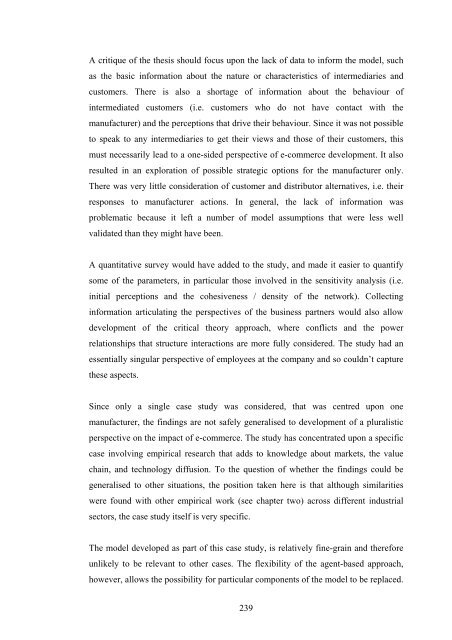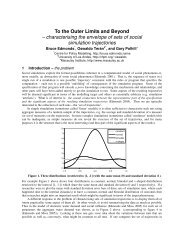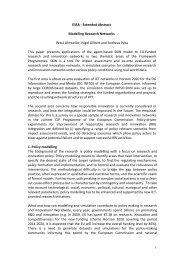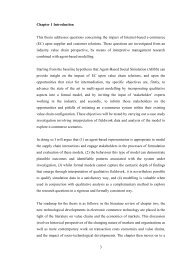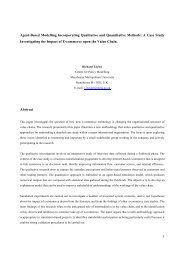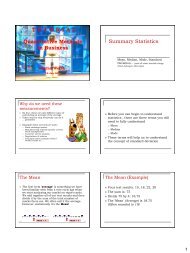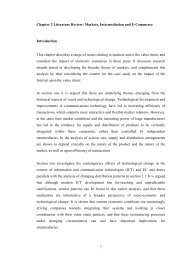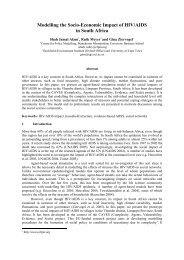222 Chapter 8 Discussion Introduction This chapter reflects on the ...
222 Chapter 8 Discussion Introduction This chapter reflects on the ...
222 Chapter 8 Discussion Introduction This chapter reflects on the ...
You also want an ePaper? Increase the reach of your titles
YUMPU automatically turns print PDFs into web optimized ePapers that Google loves.
A critique of <strong>the</strong> <strong>the</strong>sis should focus up<strong>on</strong> <strong>the</strong> lack of data to inform <strong>the</strong> model, such<br />
as <strong>the</strong> basic informati<strong>on</strong> about <strong>the</strong> nature or characteristics of intermediaries and<br />
customers. There is also a shortage of informati<strong>on</strong> about <strong>the</strong> behaviour of<br />
intermediated customers (i.e. customers who do not have c<strong>on</strong>tact with <strong>the</strong><br />
manufacturer) and <strong>the</strong> percepti<strong>on</strong>s that drive <strong>the</strong>ir behaviour. Since it was not possible<br />
to speak to any intermediaries to get <strong>the</strong>ir views and those of <strong>the</strong>ir customers, this<br />
must necessarily lead to a <strong>on</strong>e-sided perspective of e-commerce development. It also<br />
resulted in an explorati<strong>on</strong> of possible strategic opti<strong>on</strong>s for <strong>the</strong> manufacturer <strong>on</strong>ly.<br />
There was very little c<strong>on</strong>siderati<strong>on</strong> of customer and distributor alternatives, i.e. <strong>the</strong>ir<br />
resp<strong>on</strong>ses to manufacturer acti<strong>on</strong>s. In general, <strong>the</strong> lack of informati<strong>on</strong> was<br />
problematic because it left a number of model assumpti<strong>on</strong>s that were less well<br />
validated than <strong>the</strong>y might have been.<br />
A quantitative survey would have added to <strong>the</strong> study, and made it easier to quantify<br />
some of <strong>the</strong> parameters, in particular those involved in <strong>the</strong> sensitivity analysis (i.e.<br />
initial percepti<strong>on</strong>s and <strong>the</strong> cohesiveness / density of <strong>the</strong> network). Collecting<br />
informati<strong>on</strong> articulating <strong>the</strong> perspectives of <strong>the</strong> business partners would also allow<br />
development of <strong>the</strong> critical <strong>the</strong>ory approach, where c<strong>on</strong>flicts and <strong>the</strong> power<br />
relati<strong>on</strong>ships that structure interacti<strong>on</strong>s are more fully c<strong>on</strong>sidered. The study had an<br />
essentially singular perspective of employees at <strong>the</strong> company and so couldn’t capture<br />
<strong>the</strong>se aspects.<br />
Since <strong>on</strong>ly a single case study was c<strong>on</strong>sidered, that was centred up<strong>on</strong> <strong>on</strong>e<br />
manufacturer, <strong>the</strong> findings are not safely generalised to development of a pluralistic<br />
perspective <strong>on</strong> <strong>the</strong> impact of e-commerce. The study has c<strong>on</strong>centrated up<strong>on</strong> a specific<br />
case involving empirical research that adds to knowledge about markets, <strong>the</strong> value<br />
chain, and technology diffusi<strong>on</strong>. To <strong>the</strong> questi<strong>on</strong> of whe<strong>the</strong>r <strong>the</strong> findings could be<br />
generalised to o<strong>the</strong>r situati<strong>on</strong>s, <strong>the</strong> positi<strong>on</strong> taken here is that although similarities<br />
were found with o<strong>the</strong>r empirical work (see <str<strong>on</strong>g>chapter</str<strong>on</strong>g> two) across different industrial<br />
sectors, <strong>the</strong> case study itself is very specific.<br />
The model developed as part of this case study, is relatively fine-grain and <strong>the</strong>refore<br />
unlikely to be relevant to o<strong>the</strong>r cases. The flexibility of <strong>the</strong> agent-based approach,<br />
however, allows <strong>the</strong> possibility for particular comp<strong>on</strong>ents of <strong>the</strong> model to be replaced.<br />
239


